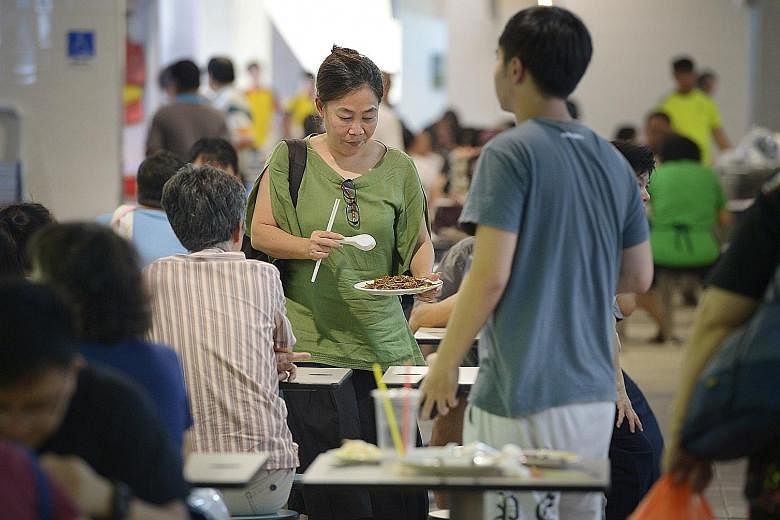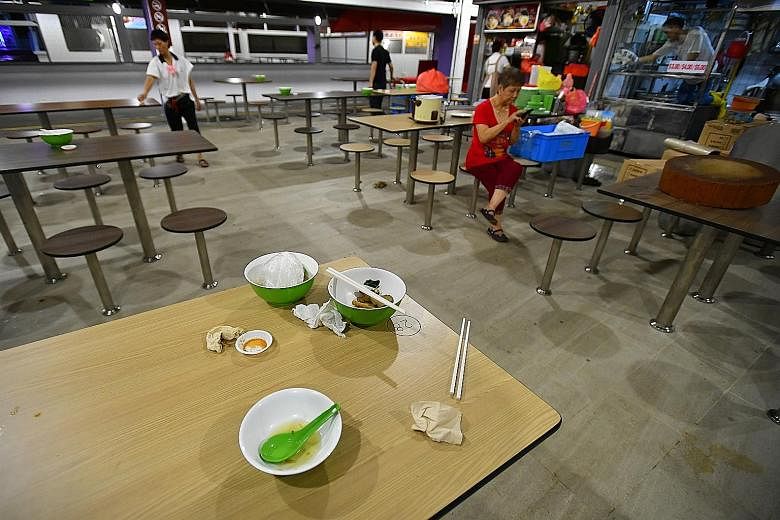It may be no easy task persuading people to return their trays at hawker centres, even with a system being rolled out that has customers paying a deposit that they get back when they return their trays.
At two hawker centres in Singapore that charge such a deposit, many people get around the system by simply not taking a tray.
Hawkers at Marsiling Mall and Bukit Merah Central food centres said 50 per cent to 90 per cent of their customers refused a tray.
These two centres are the first of up to 25 that will eventually use a tray return system which, along with centralised dish-washing services, is a means to boost productivity in a tight labour market.
Customers are charged $1 at Bukit Merah Central food centre, while patrons are charged 50 cents in Marsiling.
At Marsiling Mall Hawker Centre yesterday, which was about 90 per cent full at lunchtime, most customers The Straits Times observed did not take trays for their orders.
There were also used bowls and plates left on tables.
MIXED VIEWS ON FEE SYSTEM
Most diners don't want to incur extra cost for trays: Hawkers
Hawkers there told ST that customers do not want to incur the extra cost of 50 cents a tray.
A 59-year-old dessert stall hawker, who wanted to be known only as Mr Chan, said nine in 10 of his customers do not take a tray.
Before the system was in place, almost everyone would take one.
Mr Chan, who has been in the business for more than 30 years, said he has had unhappy customers demanding to know why they have to pay an extra fee.
One customer, Mr Ye Ah Mao, 65, who is unemployed, echoed the views of those who do not want to return their trays.
He said: "It is so troublesome because I have to walk so far to the tray return station.
"During peak hours, I also have to queue up to return the tray."
Cleaners there had varying views, with one saying that some customers even return just the tray and leave the used crockery and utensils on the table, but another noting that people generally do return their trays.
The dinner crowd at Bukit Merah Central food centre was thin but hawkers there told ST that there had been a noticeable difference in cleanliness since the system was rolled out, even though many customers, just as in Marsiling, do not want to pay the extra expense and decline to take a tray.
One Indian food stall owner pegged the number of his customers who refuse a tray at seven out of 10.
But Mr Tan Hock Soon, 59, a drinks stall owner, said the majority of customers do return the crockery and utensils they use.
"It solves the problem of birds coming to eat the leftovers on the table. There used to be a lot of birds but now, there are fewer," he said.
By and large, customers seemed to accept the necessity of clearing up after themselves, but reactions to the tray deposit system were mixed.
Civil engineer Nurul Ain, 24, said the scheme will develop a tray-returning habit in customers.
"Sometimes, when people forget (to return) their trays, I will help them to do so. It earns me an extra $1 and I can help to keep the place clean," she said.
Ms Lim Mei Chun, a manager at a pharmaceutical company who is in her 30s, felt that a reward scheme giving people points for returning their trays, which they can redeem for freebies, would be more effective.
"It is a starting point. Once the habit of returning trays is built into people, these incentives will not be needed as much," she added.
However, Mr Eric Mao, 44, a manager at an electronics company, said hawker centre managements should be stricter and make it compulsory for patrons to take a tray.
"The system fails if people choose not to take the tray and end up leaving all their bowls on the table," he said.
Advocating patience, Dr William Wan, general secretary of the Singapore Kindness Movement, said it will take time for the public to adopt a habit of returning trays.
"We can use constant yet subtle reminders, like posters, to educate and remind the public to be considerate and clear the tables for the next diner, especially during peak hours," he said.
He also urged parents to inculcate this value in their children. "If we make it enough of a habit at home, it will be a natural habit to us everywhere else."


